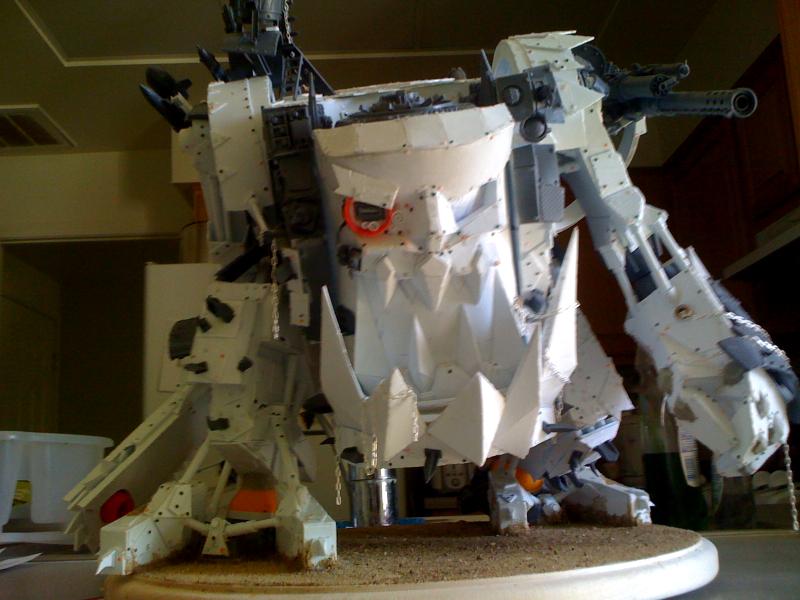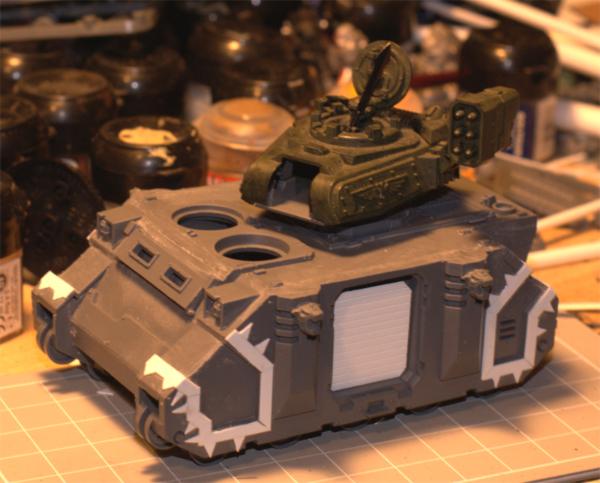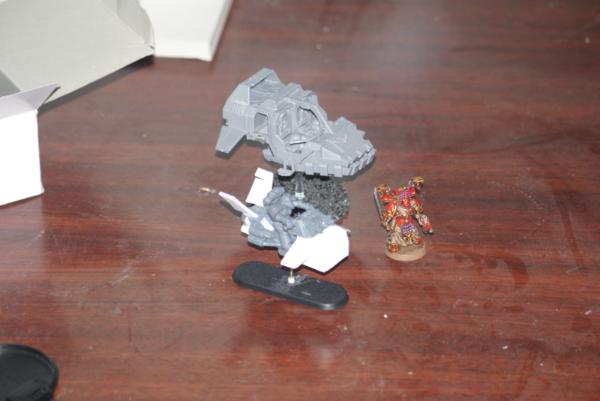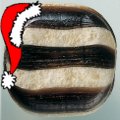| Author |
Message |
 |
|
|
 |
|
Advert
|
Forum adverts like this one are shown to any user who is not logged in. Join us by filling out a tiny 3 field form and you will get your own, free, dakka user account which gives a good range of benefits to you:
- No adverts like this in the forums anymore.
- Times and dates in your local timezone.
- Full tracking of what you have read so you can skip to your first unread post, easily see what has changed since you last logged in, and easily see what is new at a glance.
- Email notifications for threads you want to watch closely.
- Being a part of the oldest wargaming community on the net.
If you are already a member then feel free to login now. |
|
 |
![[Post New]](/s/i/i.gif) 2011/10/14 22:10:52
Subject: The plasticard conundrum.
|
 |

Fresh-Faced New User
Leicester
|
So plasticard.... People keep mentioning it and it's use.
One post below mentions the fact it will make you minatures even better?
So as a skilled gaming vet from many years ago, but new to the quality painting and modding scene....
What is plastic card?
What are the kinds of thing this is widely used for?
What effect can it have?
How does it work?
How much does it cost?
Tools?
Are there( or have you written) any tutorials?
Thanks in advance for the advice
|
The Darkness consumes! |
|
|
 |
 |
![[Post New]](/s/i/i.gif) 2011/10/14 23:45:39
Subject: The plasticard conundrum.
|
 |

Leaping Dog Warrior
|
You have posted this in the wrong section but that is okay.
Plasticard is a modeling substitute, Instead of using green stuff you can use plasticard. here is a link to a pic http://store.miniwargaming.com/product/hobby-supplies-plasticard.htm .
you could even go to the extent of blackader on his blog http://www.dakkadakka.com/dakkaforum/posts/list/372703.page .
|
|
|
|
 |
 |
![[Post New]](/s/i/i.gif) 2011/10/15 06:04:56
Subject: The plasticard conundrum.
|
 |

Scarred Ultramarine Tyrannic War Veteran
|
Plasticard is card that is plastic...Seriously it's that simple.
Plasticard is used widely in Terrain making, scratch building and converting minis.
Plasticard is tough and quite easy to work with if you have the right tools.
You can buy plastic card in many different thicknesses.
You might need a jigsaw to cut some thicknesses of plasticard but thinner through to thicker sheets can be cut with hobby knives and bone saws.
You may need to buy some hobby files to clean up some of your cuts.
Most plasticard does not stick well with plastic glue so use super glue instead.
I use plasticard that is basically free. I used the plastic lids from Ice Cream tubs which is pretty much the same thing as plasticard.
And the tutorial for plasticard will depend on what you are going to use it for. I say use google to find the type of tutorial you want.
I hope this helps!
|
|
This message was edited 3 times. Last update was at 2011/10/15 06:06:03
  "Whilst we stand, we fight. Whilst we fight, we prevail. Nothing shall stay our wrath" "Whilst we stand, we fight. Whilst we fight, we prevail. Nothing shall stay our wrath"  
 Guilliman and the Ultramarines are like Manchester United, everyone hates them because they are so awesome! Guilliman and the Ultramarines are like Manchester United, everyone hates them because they are so awesome! 
|
|
|
 |
 |
![[Post New]](/s/i/i.gif) 2011/10/15 06:46:43
Subject: The plasticard conundrum.
|
 |

[MOD]
Anti-piracy Officer
Somewhere in south-central England.
|
Plastic card is available in a variety of scales and finishes from anti-slip aluminium flooring, though granite setts, to roof tiles.
There is also a variety of plastic parts such as girders, tubes, beams, manhole covers, ladders, and the like.
It's an excellent material for making buildings.
http://www.ema-models.co.uk/
|
|
|
|
 |
 |
![[Post New]](/s/i/i.gif) 2011/10/15 12:11:34
Subject: The plasticard conundrum.
|
 |

Sneaky Kommando
|
I tend to buy it on eBay for a pittance.
I've got to disagree with Flying Pooo though as I've never had any problems using polycement on the stuff. I suppose it depends whether the plasticard you've got is styrene based though.
|
|
|
|
 |
 |
![[Post New]](/s/i/i.gif) 2011/10/15 12:22:18
Subject: The plasticard conundrum.
|
 |

Brigadier General
|
I buy the plastic for-sale signs at hardware stores as they are cheap and styrene based.
Fox Box wrote:
I've got to disagree with Flying Pooo though as I've never had any problems using polycement on the stuff. I suppose it depends whether the plasticard you've got is styrene based though.
Agreed. Standard Styrene plasticard works best with plastic glue as the solvent bonds the two pieces into one rather than sticking them together with an adhesive. A watery plastic solvent such as "plastruct" will work very quickly and effectively.
The type of plastic Flying Poo metions would work still work well for modeling, but is likely not styrene based (styrene would probably be too brittle for ice cream lids) and thus it, and other non-styrene plastics- will require superglue. I agree with most of his other information however.
|
|
|
|
 |
 |
![[Post New]](/s/i/i.gif) 2011/10/15 12:55:09
Subject: The plasticard conundrum.
|
 |

Blood-Raging Khorne Berserker
|
I use plasticard for many things,
Mostly terrain making, but some of my Ork units have some plasticard added here and there.
It's great for making clean surfaces (like armor for orks (really EASY!)) or metall plates used on vehicles or pieces of terrain.
Let your imagination work!
|
|
|
|
 |
 |
![[Post New]](/s/i/i.gif) 2011/10/15 17:39:57
Subject: The plasticard conundrum.
|
 |

Rampaging Furioso Blood Angel Dreadnought
|
Regarding the whole plastic-card vs glue thing... I've just used plastic-card (for sale signs) to base my GW buildings/terrain pieces...
What glue should I use for adding sand/grass/flock/etc onto the plastic-card base?
|
|
|
|
 |
 |
![[Post New]](/s/i/i.gif) 2011/10/15 18:39:51
Subject: Re:The plasticard conundrum.
|
 |

Regular Dakkanaut
|
I use 2mm for primary structural components (vertical and internal pieces), 1mm for most everything else (it's easier to cut and work with), and .5mm for details (like layered armor plates).
I use crazy glue for all my plastic gluing needs since it's cheap, easy to control, and dries fast and strong
(Shameless crossthread link)

|
|
This message was edited 1 time. Last update was at 2011/10/15 18:40:19
|
|
|
 |
 |
![[Post New]](/s/i/i.gif) 2011/10/15 19:03:37
Subject: Re:The plasticard conundrum.
|
 |

Longtime Dakkanaut
|
Plasticard is an awesome tool that, as evidenced above, can be used to make things that are sheer awesome, and you can claim as your own.
It can also be used in conjunction with second-hand vehicles that have been badly mauled, to restore them and then convert them to a different purpose. It's further helpful in customising vehicles as well as creating the conversions for vehicles or parts that are not made by your gaming system's manufactuerers, or creating cheaper or better looking alternatives to the official model.
My first job with plasticard was to patch up and convert a rhino into a chaos predator tank.

my second job was to convert a horribly mangled space marine bike from a bits purchase to a jet bike:

|
15 successful trades as a buyer;
16 successful trades as a seller;
To glimpse the future, you must look to the past and understand it. Names may change, but human behavior repeats itself. Prophetic insight is nothing more than profound hindsight.
It doesn't matter how bloody far the apple falls from the tree. If the apple fell off of a Granny Smith, that apple is going to grow into a Granny bloody Smith. The only difference is whether that apple grows in the shade of the tree it fell from. |
|
|
 |
 |
![[Post New]](/s/i/i.gif) 2011/10/15 19:33:13
Subject: The plasticard conundrum.
|
 |

[MOD]
Anti-piracy Officer
Somewhere in south-central England.
|
Gunzhard wrote:Regarding the whole plastic-card vs glue thing... I've just used plastic-card (for sale signs) to base my GW buildings/terrain pieces...
What glue should I use for adding sand/grass/flock/etc onto the plastic-card base?
PVA.
|
|
|
|
 |
 |
![[Post New]](/s/i/i.gif) 2011/10/15 20:13:18
Subject: Re:The plasticard conundrum.
|
 |

Stormin' Stompa
|
I use use plasticard from chopped up gift cards to make cracked bases.
|
Ask yourself: have you rated a gallery image today? |
|
|
 |
 |
![[Post New]](/s/i/i.gif) 2011/10/16 15:44:23
Subject: The plasticard conundrum.
|
 |

Rampaging Furioso Blood Angel Dreadnought
|
Kilkrazy wrote:Gunzhard wrote:Regarding the whole plastic-card vs glue thing... I've just used plastic-card (for sale signs) to base my GW buildings/terrain pieces...
What glue should I use for adding sand/grass/flock/etc onto the plastic-card base?
PVA.
The instructions for PVA say its for porous or semi-porous materials; plastic isn't porous at all right? ...I am just concerned that while the sand/grass/etc may all stay glued to itself, it might not be firmly attached to the plastic especially in the case where the card might flex a little. Did you have this working over the long term by any chance?
|
|
|
|
 |
 |
![[Post New]](/s/i/i.gif) 2011/10/16 15:54:06
Subject: The plasticard conundrum.
|
 |

Fixture of Dakka
|
Hot glue works too. Although you have to be care full not to melt you card.
|
 Avatar 720 wrote: Avatar 720 wrote:You see, to Auston, everyone is a Death Star; there's only one way you can take it and that's through a small gap at the back.
Come check out my Blood Angels,Crimson Fists, and coming soon Eldar
http://www.dakkadakka.com/dakkaforum/posts/list/391013.page
I have conceded that the Eldar page I started in P&M is their legitimate home. Free Candy! Updated 10/19.
http://www.dakkadakka.com/dakkaforum/posts/list/391553.page
Powder Burns wrote:what they need to make is a fullsize leatherman, like 14" long folded, with a bone saw, notches for bowstring, signaling flare, electrical hand crank generator, bolt cutters..
|
|
|
 |
 |
![[Post New]](/s/i/i.gif) 2011/10/17 03:10:21
Subject: The plasticard conundrum.
|
 |

Anti-Armour Swiss Guard
|
Flying Pooo wrote:
Most plasticard does not stick well with plastic glue so use super glue instead.
"plasticard' is generally just polystyrene sheet or "sheet styrene".
Contrary to what flying poo seems to believe, plastic modelling glues work fine with it (the liquid kind AND the gunge-in-a-tube types).
It is, after all, the SAME kind of plastic as is used in plastic model kits (even GWs kits - just not their "finecast" blend).
PVA is less than useless when it comes to styrene ( GW only recommend it for their clear parts to stop know-nothing 12-year olds from complaining that the (proper) glue ruined their model) UNLESS you scour the surface first to give it something more to grab onto (it will still just peel off the plastic, though).
|
I'm OVER 50 (and so far over everyone's BS, too).
Old enough to know better, young enough to not give a ****.
That is not dead which can eternal lie ...
... and yet, with strange aeons, even death may die.
|
|
|
 |
 |
![[Post New]](/s/i/i.gif) 2011/10/17 03:24:08
Subject: The plasticard conundrum.
|
 |

Rampaging Furioso Blood Angel Dreadnought
|
Yeah I tried using PVA early today... many hours later it is still not really stuck to the card. If I hold it sideways it will slide.
I would use plastic glue but I can only get small bottles around here and I am basing buildings with large footprints. Any suggestions?
|
|
|
|
 |
 |
![[Post New]](/s/i/i.gif) 2011/10/17 03:32:07
Subject: Re:The plasticard conundrum.
|
 |

Regular Dakkanaut
|
If it doesn't instantly bind your fingers together, find a different glue
|
|
|
|
 |
 |
![[Post New]](/s/i/i.gif) 2011/10/17 03:54:48
Subject: Re:The plasticard conundrum.
|
 |

Rampaging Furioso Blood Angel Dreadnought
|
delkins42 wrote:If it doesn't instantly bind your fingers together, find a different glue
Hah agreed, but does that come in huge quantities for basing buildings?
|
|
|
|
 |
 |
![[Post New]](/s/i/i.gif) 2011/10/17 06:25:46
Subject: The plasticard conundrum.
|
 |

Gargantuan Gargant
|
Regarding Gunzhard's basing issue, I'm wondering if an intermediary step would help. I've never really flexed and stressed styrene after painting, but I know that a good primer or gesso sticks pretty well to styrene, especially if the surface has been keyed. Perhaps PVA would work, after all, if applied after a strong primer with some heavy tooth?
|
The Dreadnote wrote:But the Emperor already has a shrine, in the form of your local Games Workshop. You honour him by sacrificing your money to the plastic effigies of his warriors. In time, your devotion will be rewarded with the gift of having even more effigies to worship.
|
|
|
 |
 |
![[Post New]](/s/i/i.gif) 2011/10/17 15:08:27
Subject: The plasticard conundrum.
|
 |

Rampaging Furioso Blood Angel Dreadnought
|
Hmm that is a very interesting idea... I will give it a go in fact!
...and I realize now having already tried PVA, that the flex/stressing issue is very much not the problem, it's that the product is just not secure to the plastic-card. Even a day later I can easily push it off.
Automatically Appended Next Post:
Ok UPDATE:
Dap Weldwood - Contact Cement FTW.
I went out and bought a bunch of glues for plastic, misc, PVC and laminate. A few were ok, and the testors was really good, but the bottles were just too small for large projects such as building bases. The winner was definitely the DAP contact cement, it has it's own little brush, which took a little getting used to preventing little trail-lines everywhere, but once I got the hang of it, it was perfect, and seems to hold everything in place quite well.
Next step will be priming...
|
|
This message was edited 1 time. Last update was at 2011/10/17 19:29:29
|
|
|
 |
 |
![[Post New]](/s/i/i.gif) 2011/10/18 09:16:15
Subject: The plasticard conundrum.
|
 |

Anti-Armour Swiss Guard
|
oadie wrote:Regarding Gunzhard's basing issue, I'm wondering if an intermediary step would help. I've never really flexed and stressed styrene after painting, but I know that a good primer or gesso sticks pretty well to styrene, especially if the surface has been keyed. Perhaps PVA would work, after all, if applied after a strong primer with some heavy tooth?
Slightly better result, but still a crap one.
Primers are designed so that PAINTS stick better to them.
PVA is not a paint.
It is a water soluble polymer. A plastic. A plastic that can stick to porous materials by soaking into the gaps between fibres. Primers don't have them.
|
I'm OVER 50 (and so far over everyone's BS, too).
Old enough to know better, young enough to not give a ****.
That is not dead which can eternal lie ...
... and yet, with strange aeons, even death may die.
|
|
|
 |
 |
![[Post New]](/s/i/i.gif) 2011/10/18 11:24:41
Subject: The plasticard conundrum.
|
 |

Rampaging Furioso Blood Angel Dreadnought
|
@ chromedog - yeah you are correct sir... see my post above.
DAP contact cement did the trick. Just for good measure I even scored the plastic-card a little with sand paper. But of all the plastic/pva/laminate/etc glues I tried, it was the best/most-efficient.
|
|
|
|
 |
 |
![[Post New]](/s/i/i.gif) 2011/10/18 21:38:50
Subject: The plasticard conundrum.
|
 |

Anti-Armour Swiss Guard
|
Contact cements work via a solvent action on plastics (that one does, anyway).
I've used them in the past on larger constructions (we used to use a bandsaw to cut 3mm styrene for miniature set construction, and contact cements to glue the stuff together).
|
I'm OVER 50 (and so far over everyone's BS, too).
Old enough to know better, young enough to not give a ****.
That is not dead which can eternal lie ...
... and yet, with strange aeons, even death may die.
|
|
|
 |
 |
|
|